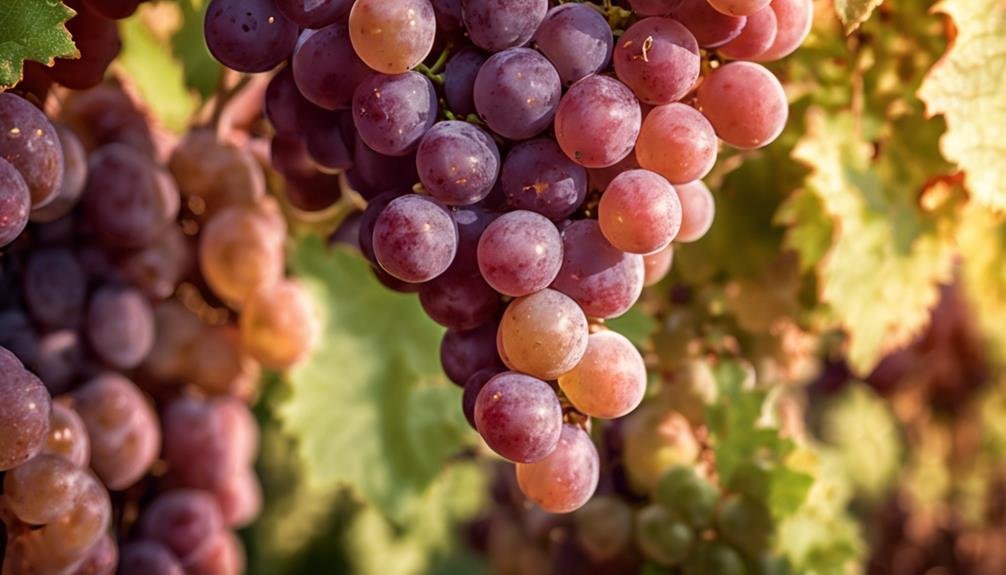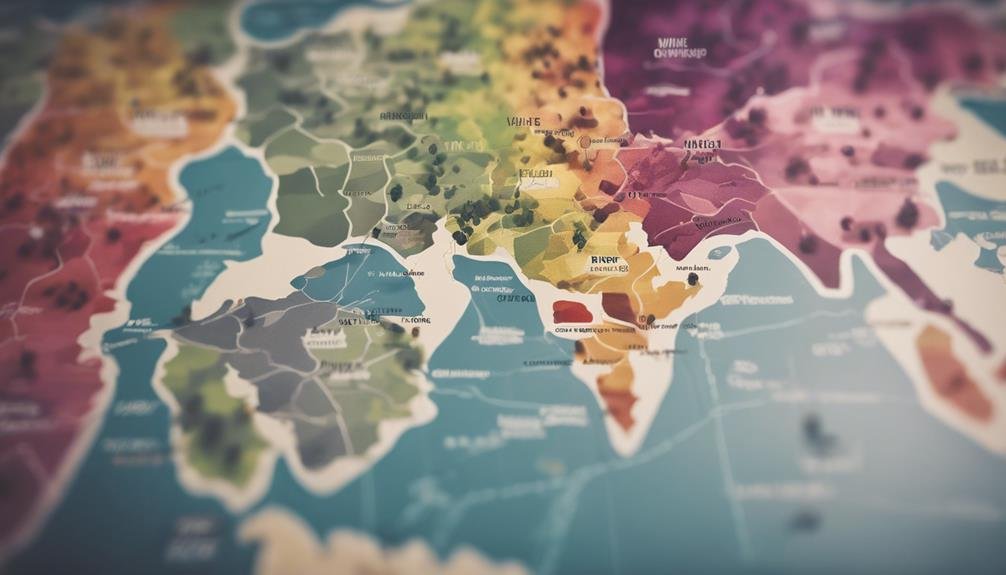Discover the intriguing world of Pinot varieties, each with unique genetic relationships and grape mutations. With over 1,000 registered clones, Pinot Noir, Pinot Blanc, and Pinot Gris offer diverse tastes and aromas. The clonal diversity shapes the wine's quality, making it essential for winemakers to understand the genetic makeup and clone attributes. Explore the rich history of Pinot Noir dating back to the 1300s in Burgundy, with over 40 documented clones influencing flavors. Pinot Gris showcases a broad spectrum of flavors, influenced by regional factors like climate and soil. Pinot Blanc, known for its invigorating acidity, pairs beautifully with seafood and salads. Uncover the secrets behind these intriguing varietals.
Pinot Varieties and Clones Overview
An overview of Pinot varieties and clones reveals the intricate genetic relationships and diverse characteristics shared among the Pinot Noir, Pinot Blanc, and Pinot Gris grape variations. Grape mutations have led to unique flavors within these varieties.
Clonal diversity plays a significant role in the winemaking impact of Pinot grapes, influencing the taste, aroma, and overall quality of the wines produced. With over 1,000 registered clones of Pinot in existence, the variations in clonal selections have a direct effect on the final product.
Understanding the genetic makeup of these grape mutations and the specific attributes each clone contributes is essential for winemakers aiming to craft exceptional wines that showcase the distinct qualities of Pinot Noir, Pinot Blanc, and Pinot Gris.
Pinot Noir History and Clones
Exploring the historical roots and genetic diversity of Pinot Noir reveals a rich tapestry of influences shaping this renowned grape variety. Pinot Noir evolution showcases its journey from the 1300s in Burgundy to over 40 documented clones today, each impacting flavor differently. Clonal influence in Pinot Noir is significant, with popular variations like Dijon 113, Dijon 115, Pommard 5, and Dijon 777 offering distinct characteristics to winemakers. The diversity of clones is valued for the nuances they bring to winemaking, allowing for a range of expressions in the final product. The table below summarizes some key clonal variations of Pinot Noir:
| Clonal Variation | Characteristics |
|---|---|
| Dijon 113 | Lighter body, floral notes |
| Dijon 115 | Richer, deeper flavors |
| Pommard 5 | Bold, structured tannins |
| Dijon 777 | Bright acidity, red fruit notes |
| ENTAV 115 | Elegant, balanced profile |
Pinot Gris Flavor Diversity

Diving into the intricate spectrum of flavors found within Pinot Gris wines reveals a mesmerizing tapestry of taste profiles. Exploring palate diversity, Pinot Gris wines exhibit a wide array of flavors, ranging from vibrant citrus and stone fruits to delicate floral notes and hints of spice.
Regional influences play a significant role in shaping the flavor profile of Pinot Gris, with variations in climate and soil contributing to the diversity of styles produced. Whether from Alsace, Oregon, or Italy, each region imparts its unique characteristics, creating a fascinating range of expressions.
The versatility of Pinot Gris allows winemakers to craft wines that showcase the grape's potential, making it a compelling choice for both enthusiasts and newcomers to the modern wine world.
Pinot Blanc Characteristics
Pinot Blanc, a variety often overshadowed by its more popular counterparts, offers distinctive characteristics that make it a valuable asset in the winemaking world. Known for its invigorating acidity, Pinot Blanc produces invigorating white wines that are versatile and food-friendly.
This grape variety is ideal for pairing with a variety of dishes, including seafood, poultry, salads, and light pasta dishes. The bright acidity of Pinot Blanc cuts through rich and creamy foods, balancing flavors and enhancing the overall dining experience.
Whether enjoyed on its own or paired with food, Pinot Blanc's vibrant acidity and subtle fruit notes make it a delightful choice for those seeking a well-rounded and elegant white wine option.
Wine Education With Wine Folly

Wine Folly's innovative approach to wine education revolutionizes the way enthusiasts learn about wine, offering accessible resources and valuable insights. Through visually engaging infographics and expertly crafted content, Wine Folly simplifies complex wine concepts, making them easy to grasp for beginners and connoisseurs alike.
Their focus on practical tasting techniques enhances the learning experience, empowering individuals to explore and appreciate wines with confidence. Madeline Puckette, co-founder of Wine Folly, has become a well-known figure in the wine world for her dedication to providing accessible wine education.
The free newsletter offered by Wine Folly serves as a valuable tool for jumpstarting wine education and staying updated on the latest wine-related content, making the journey of learning about wine both enriching and enjoyable.
Frequently Asked Questions
What Are the Key Differences Between Pinot Noir Clones?
Key differences between Pinot Noir clones lie in their clone characteristics, impacting flavor profiles. Regional preferences influence which clones are favored for winemaking, showcasing diversity in styles. Understanding these distinctions enhances appreciation for the nuanced world of Pinot Noir wines.
How Do Winemakers Select the Best Pinot Gris Berries?
Winemakers meticulously select the finest Pinot Gris berries by gauging their peak ripeness levels, akin to choosing jewels from a treasure trove. Harvest timing, coupled with precise fermentation methods and strategic aging techniques, are key influencers in crafting exceptional Pinot Gris wines.
Are There Any Unique Regional Expressions of Pinot Blanc?
Regional expressions of Pinot Blanc showcase diverse characteristics influenced by terroir and winemaking techniques. Unique traits emerge in regions like Alsace, Italy, and Austria. Each area imparts distinct flavors, aromas, and textures, reflecting their heritage and expertise.
Can Wine Folly Help With Wine Pairing Suggestions?
Wine Folly, a trusted resource for wine education, offers valuable insights on wine pairing suggestions. By enhancing wine knowledge, individuals can confidently select wines that complement their meals, improving their overall dining experience through informed choices.
How Can One Identify the Best Pinot Noir Clone for a Specific Region?
Identifying the best Pinot Noir clone for a specific region involves studying soil composition, microclimate, vineyard management, and fermentation techniques. Understanding these factors helps match the clone's characteristics with the terroir to enhance wine quality and express regional nuances.
Conclusion
To sum up, immersing oneself in the world of Pinot varieties reveals a fascinating journey through history, flavors, and possibilities.
From the ancient roots of Pinot Noir to the diverse characteristics of Pinot Gris and Pinot Blanc, each glass of Pinot wine holds a unique story waiting to be explored.
By unraveling the mystery of these esteemed varieties and their intricate nuances, wine enthusiasts can deepen their appreciation for the art and science of winemaking.
Cheers to the endless discoveries that await in every sip of Pinot wine.
